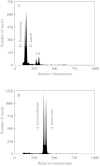Nuclear DNA amounts in Macaronesian angiosperms
- PMID: 12824074
- PMCID: PMC4243629
- DOI: 10.1093/aob/mcg104
Nuclear DNA amounts in Macaronesian angiosperms
Abstract
Nuclear DNA contents for 104 Macaronesian angiosperms, with particular attention on Canary Islands endemics, were analysed using propidium iodide flow cytometry. Prime estimates for more than one-sixth of the whole Canarian endemic flora (including representatives of 11 endemic genera) were obtained. The resulting 1C DNA values ranged from 0.19 to 7.21 pg for Descurainia bourgeauana and Argyranthemum frutescens, respectively (about 38-fold difference). The majority of species, however, possessed (very) small genomes, with C-values <1.6 pg. The tendency towards small nuclear DNA contents and genome sizes was confirmed by comparing average values for Macaronesian and non-Macaronesian representatives of individual families, genera and major phylogenetic lineages. Our data support the hypothesis that the insular selection pressures in Macaronesia favour small C-values and genome sizes. Both positive and negative correlations between infrageneric nuclear DNA amount variation and environmental conditions on Tenerife were also found in several genera.
Figures



Similar articles
-
Nuclear DNA amounts in angiosperms: targets, trends and tomorrow.Ann Bot. 2011 Mar;107(3):467-590. doi: 10.1093/aob/mcq258. Epub 2011 Jan 21. Ann Bot. 2011. PMID: 21257716 Free PMC article. Review.
-
New reports of nuclear DNA content for 407 vascular plant taxa from the United States.Ann Bot. 2012 Dec;110(8):1623-9. doi: 10.1093/aob/mcs222. Epub 2012 Oct 24. Ann Bot. 2012. PMID: 23100602 Free PMC article.
-
Evolution of genome size and chromosome number in the carnivorous plant genus Genlisea (Lentibulariaceae), with a new estimate of the minimum genome size in angiosperms.Ann Bot. 2014 Dec;114(8):1651-63. doi: 10.1093/aob/mcu189. Epub 2014 Oct 1. Ann Bot. 2014. PMID: 25274549 Free PMC article.
-
Evolution of DNA amounts across land plants (embryophyta).Ann Bot. 2005 Jan;95(1):207-17. doi: 10.1093/aob/mci014. Ann Bot. 2005. PMID: 15596468 Free PMC article.
-
Nuclear DNA amounts in angiosperms: progress, problems and prospects.Ann Bot. 2005 Jan;95(1):45-90. doi: 10.1093/aob/mci003. Ann Bot. 2005. PMID: 15596457 Free PMC article. Review.
Cited by
-
Genome size variation and evolution in Veronica.Ann Bot. 2004 Dec;94(6):897-911. doi: 10.1093/aob/mch219. Epub 2004 Nov 1. Ann Bot. 2004. PMID: 15520022 Free PMC article.
-
Diversity and Cytogenomic Characterization of Wild Carrots in the Macaronesian Islands.Plants (Basel). 2021 Sep 18;10(9):1954. doi: 10.3390/plants10091954. Plants (Basel). 2021. PMID: 34579486 Free PMC article.
-
Obtainment and confirmation of intergeneric hybrids between marguerite (Argyranthemum frutescens (L.) Sch.Bip.) and two Rhodanthemum species (R. hosmariense (Ball) B. H. Wilcox, K. Bremer & Humphries and R. catananche (Ball) B. H. Wilcox, K. Bremer & Humphries).Plant Biotechnol (Tokyo). 2023 Jun 25;40(2):135-143. doi: 10.5511/plantbiotechnology.23.0202a. Plant Biotechnol (Tokyo). 2023. PMID: 38250296 Free PMC article.
-
Evolution of genome size in Carex (Cyperaceae) in relation to chromosome number and genomic base composition.Ann Bot. 2013 Jan;111(1):79-94. doi: 10.1093/aob/mcs239. Epub 2012 Nov 21. Ann Bot. 2013. PMID: 23175591 Free PMC article.
-
The Evolution of Cytogenetic Traits in Cuscuta (Convolvulaceae), the Genus With the Most Diverse Chromosomes in Angiosperms.Front Plant Sci. 2022 Apr 1;13:842260. doi: 10.3389/fpls.2022.842260. eCollection 2022. Front Plant Sci. 2022. PMID: 35432411 Free PMC article.
References
-
- BarberJC, Francisco‐Ortega J, Santos‐Guerra A, Marrero A, Jansen RK.2000. Evolution of endemic Sideritis (Lamiaceae) in Macaronesia: insights from a chloroplast DNA restriction site analysis. Systematic Botany 25: 633–647.
-
- BennettMD.1972. Nuclear DNA content and minimum generation time in herbaceous plants. Proceedings of the Royal Society of London 181: 109–135. - PubMed
-
- BennettMD, Leitch IJ.1995. Nuclear DNA Amounts in Angiosperms. Annals of Botany 76: 113–176.
-
- BennettMD, Leitch IJ.2001.Angiosperm DNA C‐values database (release 3·1, Sept. 2001). http://www.rbgkew.org.uk/cval/home page.html
-
- BennettMD, Bhandol P, Leitch IJ.2000. Nuclear DNA amounts in angiosperms and their modern uses – 807 new estimates. Annals of Botany 86: 859–909.

